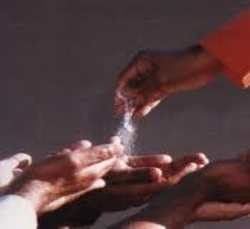In Addition
Vol 15 अंक 6
November / December 2024
Health article
Keep the Accessory Digestive Organs Healthy
“Thick milk contains plenty of fat, calcium, and glucose. When blood is saturated with too much glucose, it turns the residual glucose into acid. The result is that you develop boils. This acid and blood combine to form stones in the gall bladder. Avoid taking excess of curds, they have too much protein… One has to be vigilant about food and drink consumed by both body and mind.” …Sathya Sai Baba1-4
Introduction
We had dealt with the organs of the digestive system in the previous health articles on “Oral health” and “Healthy Gut Healthy Life” published in the newsletters (vol 12 # 2, March-April 2021 and vol 15 # 3, May-June 2024).5,6 This article will dwell upon the accessory organs of the digestive system which are glandular in nature, namely, salivary glands, Liver, Gall Bladder, and Pancreas; though not a part of the digestive tract, they play a pivotal role in digestion by releasing fluids and enzymes to break down food.7
1. Role of Salivary glands and saliva
1.1 Our mouth has three major salivary glands, beneath and in front of the ears, under the lower jaw and underneath the tongue, with many minor glands dispersed throughout the lips, mouth, cheeks, and throat, to aid in digestion. Every day, these glands produce 0.5 to 1.5 litres of saliva, which is a complex mixture of 99% water and some proteins, enzymes, and mucus. Food first 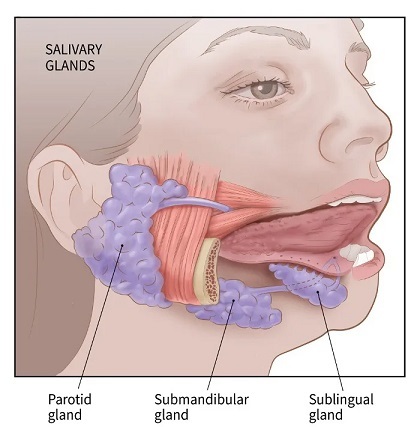 gets mixed with saliva before the taste buds react. Saliva keeps the mouth moist to make chewing, swallowing, and speaking easier, lubricates food, protects against infections, improves taste perception, and dilutes and neutralizes the stomach acid. Just one drop of saliva contains a sample of our complete genetic make-up.8,9
gets mixed with saliva before the taste buds react. Saliva keeps the mouth moist to make chewing, swallowing, and speaking easier, lubricates food, protects against infections, improves taste perception, and dilutes and neutralizes the stomach acid. Just one drop of saliva contains a sample of our complete genetic make-up.8,9
1.2 Disorders could be salivary gland infections caused by bacteria or virus eg, mumps, a contagious viral disease that can swell up these glands, accompanied by severe pain and fever, mostly affecting children between the ages of 2 and 12; less saliva production may lead to dry mouth and tooth decay, common among adults due to some health condition, treatment, or medication; blockage of glands due to stones, cysts, or tumours and some diseases.8-11
1.3 Symptoms of salivary gland disorders are swelling in the face, neck, or under the tongue, lumps in the cheek, jaw, lip, or inside the mouth, bad taste or unpleasant smell in the mouth, weakness or numbness in the face, pain in the mouth or face while eating, difficulty opening the mouth, redness on the side of face or upper neck, or fluid from ear, with or without fever and headache.8-11
2. Vibrant liver - major metabolic organ
2.1 Structure: The dark reddish brown cone shaped liver with four main lobes, two large and two small, and many lobules 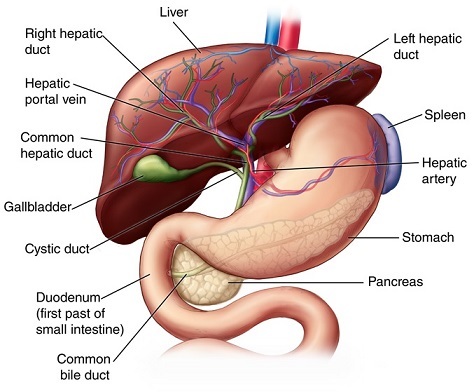 is the largest internal organ and gland in the body weighing about 1.4Kg (3.1 lb), located at the upper right abdomen, beneath the diaphragm, and on top of the stomach, right kidney, and intestines.12-16
is the largest internal organ and gland in the body weighing about 1.4Kg (3.1 lb), located at the upper right abdomen, beneath the diaphragm, and on top of the stomach, right kidney, and intestines.12-16
2.2 Functions of liver: Critical for health, liver plays a central role in more than 500 metabolic 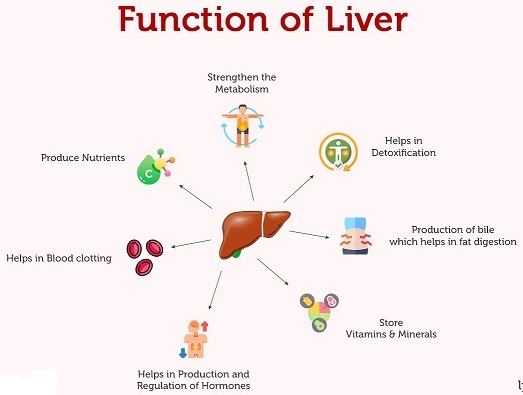 processes in the body to nourish it and keep it safe from toxic elements and to sustain life. Blood from the digestive organs (stomach and intestines), carrying nutrients, medication and toxic substances, flows through the portal vein to the liver. The liver synthesises and metabolises fats, proteins and carbs, balances/regulates blood levels of amino acids, makes the nutrients absorbable, and detoxifies the system from medications, drugs, alcohol, ammonia, and caffeine. It also stores vitamins A, D, E, K, and B12, minerals like iron and copper, and glycogen, processes haemoglobin and regulates blood clotting, maintains the level of bilirubin (a pigment that gives bile and stool its distinctive yellow colour; it is a by-product of broken-down red blood cells), removes excess glucose from blood and releases when needed, and eliminates bacteria. Liver produces every day nearly 0.8 to one litre of bile to help emulsify fats and lipids and assimilate them. Waste is excreted into the bile or blood. Bile by-products enter the intestine and leave the body as faeces. Metabolic by-products are filtered out by the kidneys and leave the body in the form of urine.12-17
processes in the body to nourish it and keep it safe from toxic elements and to sustain life. Blood from the digestive organs (stomach and intestines), carrying nutrients, medication and toxic substances, flows through the portal vein to the liver. The liver synthesises and metabolises fats, proteins and carbs, balances/regulates blood levels of amino acids, makes the nutrients absorbable, and detoxifies the system from medications, drugs, alcohol, ammonia, and caffeine. It also stores vitamins A, D, E, K, and B12, minerals like iron and copper, and glycogen, processes haemoglobin and regulates blood clotting, maintains the level of bilirubin (a pigment that gives bile and stool its distinctive yellow colour; it is a by-product of broken-down red blood cells), removes excess glucose from blood and releases when needed, and eliminates bacteria. Liver produces every day nearly 0.8 to one litre of bile to help emulsify fats and lipids and assimilate them. Waste is excreted into the bile or blood. Bile by-products enter the intestine and leave the body as faeces. Metabolic by-products are filtered out by the kidneys and leave the body in the form of urine.12-17
2.3 Liver disorders: Liver has great regenerative power, but too many toxins can overwhelm it and give way to chronic diseases, mostly due to faulty living. There are over 100 types of liver diseases which can be reversed or managed in the early stages. A well-known liver problem is jaundice, where the skin and the whites of the  eyes turn yellow because of too much bilirubin. Common in newborns and infants, it goes away within a couple of weeks, usually not serious. It is not a disease in itself but a symptom to indicate an underlying health problem. Liver diseases can be congenital, or due to autoimmune or cardiovascular diseases too, apart from infections and toxins. Metabolic conditions associated with obesity, high blood sugar or lipids can cause excess fat storage in liver causing inflammation known as non-alcohol related fatty liver disease. Hepatitis which is an inflammation of the liver can take varied forms; it can be infectious too!15,18-20
eyes turn yellow because of too much bilirubin. Common in newborns and infants, it goes away within a couple of weeks, usually not serious. It is not a disease in itself but a symptom to indicate an underlying health problem. Liver diseases can be congenital, or due to autoimmune or cardiovascular diseases too, apart from infections and toxins. Metabolic conditions associated with obesity, high blood sugar or lipids can cause excess fat storage in liver causing inflammation known as non-alcohol related fatty liver disease. Hepatitis which is an inflammation of the liver can take varied forms; it can be infectious too!15,18-20
2.4 Viral hepatitis is grouped as A, B, C, D, and E. Hepatitis A is found in the faeces of an infected person and can easily spread through contaminated food or water, usually acute and treatable. Hepatitis B, the most infectious, lives in blood and sexual fluids, and is often passed from mother to the baby during child birth. People can carry the virus without feeling  sick but still spread the virus through infected blood and unprotected sex. Though not considered curable, and also a primary cause of liver cancer, one can lead a normal life with regular check-ups. Hepatitis C normally spreads through blood-to-blood contact or contaminated needles and is curable. Both B & C can lead to chronic conditions. A & B can be prevented by getting a vaccine; there is no vaccine for Hepatitis C. Hepatitis D, though rare, infects those who have B. Hepatitis E caused by ingestion of contaminated water is most prevalent in Asia; though vaccines exist, they are not available everywhere.21-24
sick but still spread the virus through infected blood and unprotected sex. Though not considered curable, and also a primary cause of liver cancer, one can lead a normal life with regular check-ups. Hepatitis C normally spreads through blood-to-blood contact or contaminated needles and is curable. Both B & C can lead to chronic conditions. A & B can be prevented by getting a vaccine; there is no vaccine for Hepatitis C. Hepatitis D, though rare, infects those who have B. Hepatitis E caused by ingestion of contaminated water is most prevalent in Asia; though vaccines exist, they are not available everywhere.21-24
2.5 Four stages of a Chronic liver disease: It starts with an episode of acute hepatitis with initial symptoms of fever, upper abdominal pain, nausea 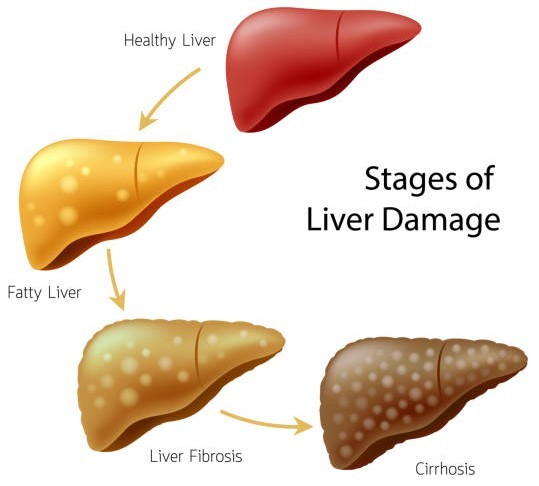 or loss of appetite, and fatigue, sometimes with enlarged liver/spleen. Second stage is fibrosis, a gradual stiffening of liver reducing its vitality. It is indicated by jaundice, dark urine, pale stool, weight loss and muscle loss, musty smelling breath, difficulties in digesting fats, and itchy skin. If undetected, over the years, symptoms can intensify with pain in abdomen, tremors, loss of balance or constant fatigue, confusion, discolouration and change in shape and growth of nails and skin, easy bleeding or bruising, ascites (swollen abdomen), and swollen ankles, feet, hands, and face. The third stage is cirrhosis, severe permanent scarring of liver causing nearly irreversible damage; most common cause of deterioration being alcohol and drugs, viruses, and metabolic factors. The end stage, though rare is liver failure when it can no longer function adequately.25-26
or loss of appetite, and fatigue, sometimes with enlarged liver/spleen. Second stage is fibrosis, a gradual stiffening of liver reducing its vitality. It is indicated by jaundice, dark urine, pale stool, weight loss and muscle loss, musty smelling breath, difficulties in digesting fats, and itchy skin. If undetected, over the years, symptoms can intensify with pain in abdomen, tremors, loss of balance or constant fatigue, confusion, discolouration and change in shape and growth of nails and skin, easy bleeding or bruising, ascites (swollen abdomen), and swollen ankles, feet, hands, and face. The third stage is cirrhosis, severe permanent scarring of liver causing nearly irreversible damage; most common cause of deterioration being alcohol and drugs, viruses, and metabolic factors. The end stage, though rare is liver failure when it can no longer function adequately.25-26
3. Role of Gallbladder in digestion
3.1 A small pear-shaped organ located just beneath the liver, it stores bile, also called gall. Before we start eating, gallbladder is full of bile. As we start eating, it gets released into duodenum when fat-containing-food is detected. After we eat, it gets emptied resembling a deflated balloon waiting to be filled up again.27
3.2 Diseases of gallbladder: The most common is gallstones - hard deposits of cholesterol and bilirubin, these develop in gallbladder or bile ducts. When level of cholesterol in bile becomes too high, excess cholesterol forms into stones and most patients are unaware of it. Though usually considered harmless, they can cause inflammation, nausea, vomiting, upper-right or mid-abdominal pain especially after a fatty meal, radiating to right shoulder or back, light brown stoo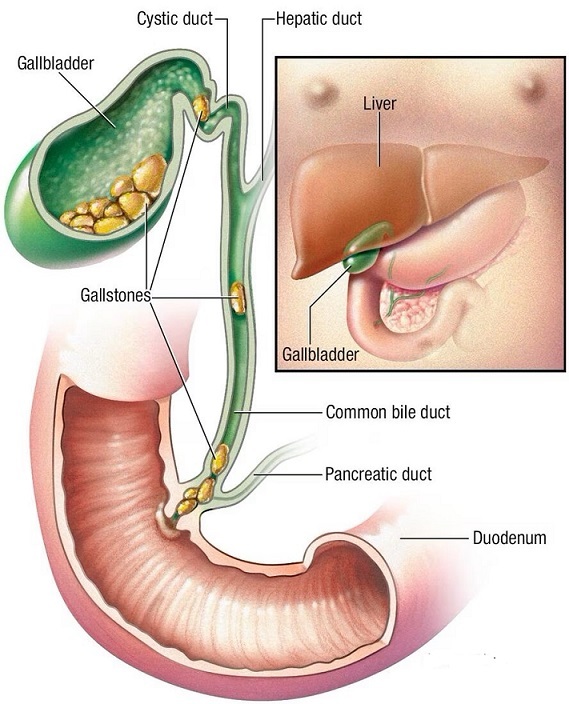 l, fever or chill, and jaundice. If the gallstones block the movement of bile due to inflammation of gallbladder, it is called cholecystitis with symptoms of severe pain and fever requiring surgery and removal of gallbladder (cholecystectomy). It is said one can lead a normal life without this organ. However, as an after-effect, all the bile starts flowing directly from liver to intestine. Without any storage for extra bile there will be difficulty digesting fat. until the body readjusts itself. So, at least for a few weeks post-surgery, one must avoid fried and greasy foods. Later, gradually reintroduce high fibre foods to prevent bloating and gas, keeping fat calories in the diet to a tolerable minimum.27-30
l, fever or chill, and jaundice. If the gallstones block the movement of bile due to inflammation of gallbladder, it is called cholecystitis with symptoms of severe pain and fever requiring surgery and removal of gallbladder (cholecystectomy). It is said one can lead a normal life without this organ. However, as an after-effect, all the bile starts flowing directly from liver to intestine. Without any storage for extra bile there will be difficulty digesting fat. until the body readjusts itself. So, at least for a few weeks post-surgery, one must avoid fried and greasy foods. Later, gradually reintroduce high fibre foods to prevent bloating and gas, keeping fat calories in the diet to a tolerable minimum.27-30
4. Role of Pancreas in digestion
4.1 Located inside the upper left abdomen just behind the stomach, size of our hand, the tadpole-shaped pancreas has a dual role as an organ of both digestive (90%) and endocrine system (10%). The exocrine (with ducts) component of pancreas produces juices called enzymes to digest food, esp. sugar, fat, and starches; the endocrine (ductless) component makes hormones including insulin to help regulate blood sugar levels and appetite, stimulate stomach acids, and message the stomach when to empty.13,31-33
4.2 Pancreatic disorders, hard to diagnose due to the location of the organ, include diabetes, pancreatitis (inflammation of pancreas), and pancreatic cancer. When a gallstone travels and  blocks the pancreatic duct, it may lead to pancreatitis causing severe abdominal pain. Chronic pancreatitis is caused by alcohol consumption and if 90% of pancreas stops working, it causes diarrhoea, weight loss, and malnutrition.31-33
blocks the pancreatic duct, it may lead to pancreatitis causing severe abdominal pain. Chronic pancreatitis is caused by alcohol consumption and if 90% of pancreas stops working, it causes diarrhoea, weight loss, and malnutrition.31-33
5. Tips to prevent diseases
Have a healthy life style and keep weight in check with a healthy fibre-rich diet of wholegrains, fresh fruits, and vegetables to keep all the glandular digestive organs healthy. Avoid high fat, sugar, and salt in diet.34,35
Keep the mouth moist: Drink adequate fluids (diet itself should have enough water content), take small bites of food and chew well, practise good oral hygiene, chew sugarless candies or figs to stimulate saliva and avoid commercial mouthwashes, acidic drinks, and tobacco.8-11
Keep the Liver alive. Many liver diseases are not detected in early stages. So, avoid toxins like smoking, immoderate drinking, and exposure to chemicals. Take safety measures to prevent infections and transmission of disease.16,34,35
Prevent gallstones and pancreatitis by including nuts, especially pistachio, walnuts, cashews, peanuts, olive oil, and omega-3 fatty acids in diet; consume coffee in moderation.36,37
References and Links
- Sathya Sai on preventing gallstones: https://sathyasaiwithstudents.blogspot.com/2014/03/three-point-personal-lifestyle-charter.html
- http://saibaba.ws/teachings/foodforhealthy.htm
- https://static.ssssoindia.org/wp_uploads/2018/03/26172212/Preventive-Health-Care-Module.pdf; page 15
- Sathya Sai Baba Divine Discourse of Ramanavami on healthy living, “Pappu and Uppu”, 19 April 1965 : https://sssbpt.info/ssspeaks/volume05/sss05-33.pdf
- Oral health: https://news.vibrionics.org/en/articles/337, vol 12, #2, Mar-Apr 2021
- Healthy Gut Healthy Life: https://news.vibrionics.org/en/articles/437 , vol 15 #3, May-June 2024
- Accessory organs of digestive system: https://training.seer.cancer.gov/anatomy/digestive/regions/
- Salivary glands: https://www.mayoclinichealthsystem.org/hometown-health/speaking-of-health/understanding-salivary-gland-conditions
- https://my.clevelandclinic.org/health/body/23462-salivary-glands
- Salivary gland disorders: https://www.msdmanuals.com/home/ear-nose-and-throat-disorders/mouth-and-throat-disorders/salivary-gland-disorders
- Symptoms of salivary gland problems: https://www.nidcr.nih.gov/health-info/saliva-salivary-gland-disorders#
- Liver: https://www.hopkinsmedicine.org/health/conditions-and-diseases/liver-anatomy-and-functions
- Taber’s Cyclopedic Medical Dictionary, Edition 20, 2001, page 1259,1576.
- How does liver work: https://www.ncbi.nlm.nih.gov/books/NBK279393/#
- https://my.clevelandclinic.org/health/articles/21481-liver
- https://columbiasurgery.org/liver/liver-and-its-functions
- What is bilirubin: https://my.clevelandclinic.org/health/diagnostics/17845-bilirubin
- Liver diseases: https://my.clevelandclinic.org/health/diseases/17179-liver-disease
- Jaundice in newborns: https://my.clevelandclinic.org/health/diseases/22263-jaundice-in-newborns
- Adult jaundice: https://my.clevelandclinic.org/health/symptoms/15367-adult-jaundice
- Hepatitis: https://www.health.ny.gov/diseases/communicable/hepatitis/#
- https://www.hep.org.au/blog/difference-between-hepatitis-a-b-c/
- https://my.clevelandclinic.org/health/diseases/hepatitis
- https://www.hepb.org/what-is-hepatitis-b/the-abcs-of-viral-hepatitis/
- Liver Fibrosis: https://www.hoag.org/specialties-services/digestive-health/diseases-conditions/liver-fibrosis/
- Cirrhosis of liver: https://my.clevelandclinic.org/health/diseases/15572-cirrhosis-of-the-liver
- Gall bladder: https://my.clevelandclinic.org/health/body/21690-gallbladder
- Gallstones: https://my.clevelandclinic.org/health/diseases/7313-gallstones
- Cholecystectomy: https://my.clevelandclinic.org/health/procedures/21614-gallbladder-removal
- Diet after gall bladder removal: https://www.medicalnewstoday.com/articles/diet-after-gallbladder-removal
- Pancreas: https://www.hopkinsmedicine.org/health/conditions-and-diseases/the-digestive-process-what-is-the-role-of-your-pancreas-in-digestion
- https://columbiasurgery.org/pancreas/pancreas-and-its-functions
- https://my.clevelandclinic.org/health/body/21743-pancreas
- Liver Health: Do’s and Don’ts: https://www.hopkinsmedicine.org/health/wellness-and-prevention/liver-health-infographic
- Healthy liver Tips: https://liverfoundation.org/resource-center/blog/healthy-liver-tips/
- Prevent gall stones: https://www.niddk.nih.gov/health-information/digestive-diseases/gallstones/eating-diet-nutrition
- https://www.medanta.org/patient-education-blog/6-ways-to-prevent-gall-bladder-stone
2. Camps & Clinics
Vidya Jyothi School, Kukatpally, Medchal Malkajgiri District, Telangana, 18 Oct 2024
The camp was inaugurated in a government school on behalf of the Sai Samithi. After the School Principal addressed the children the Samithi convenor gave a short talk on the efficacy of vibrionics, based on his own experiences, followed by an introduction to Vibrionics by Practitioner 11656. A total of 23 patients were treated for various ailments, knee arthritis, leg pain, body pain, weakness, respiratory allergy, cold, cough, headache, migraine, stomach problems, ear infections, back pain, menses issues, muscle cramps.
This clinic will be run once a month from 10 am to 2 pm by Practitioners 11656, 11632 with the help of sevadals from the Kukatpally Samithi.
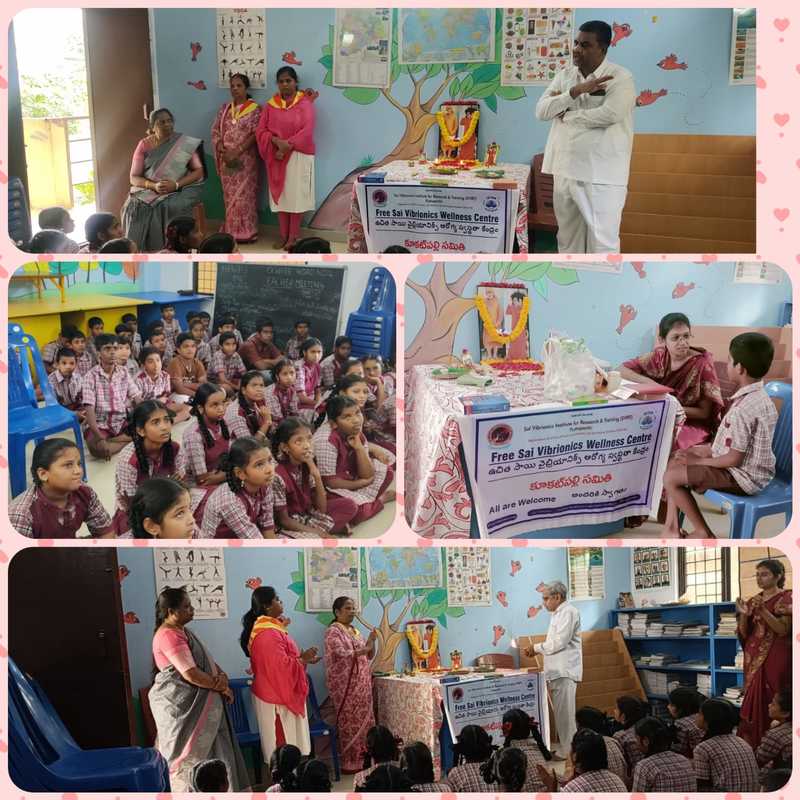
3. Anecdotes
1. From the diary of Dr Jit K Aggarwal: Stunning response to a tiny pill!
Going back to those early days of vibrionics practice in mid-nineties, one evening after Swami’s darshan, a very tall and brawny man from the USA visited the clinic seeking remedy for his chronic back problem. After asking a few questions Dr Aggarwal prepared NM38 Back Pain using the SRHVP. He put one pill in the patient’s mouth and gave him the remedy bottle asking him to come back in a week’s time. Non-plussed, the patient looked at the bottle of tiny pills, and with a queer expression on his face, he asked with indignation as to what that tiny pill could do to this huge body. ‘Let’s see what Swami does?’ was the prompt reply. The next morning, the patient landed at his doorstep with a bewildered look, narrated with exasperation how the whole night his body was shaking with vibrations, and he could not sleep a wink! Totally awed he blurted out, ‘What did you give me, an atom bomb?’ With such a huge pullout, it was obviously the correct remedy for his problem and a great knowing for both the patient and the practitioner! Needless to say that his pain vanished before he left the ashram a few days later.
2. Amazing power of nosode 00030…India An 80-year-old man with progressive metastatic prostate cancer started in Sept 2024 Lutetium 177 therapy, a treatment which uses a radioactive agent that specifically targets and kills cancer cells. A side effect of this therapy is a "bystander effect" where the radioactive agent affects the normal bone tissue surrounding the cancer cells, resulting in severe fatigue. Additionally, destruction of cancer cells itself can cause fatigue and flare-up of bone pains which may last for several weeks after treatment. As the metastatic lesions were widespread throughout his skeletal system, he was experiencing severe fatigue the day after therapy, likely due to the 'bystander effect'. He found it difficult to sit, stand, or walk, and almost became bedridden. As a sample of the injection needed for making a nosode was not available, the same was prepared from his saliva (radioactive agent is eliminated through saliva and urine) at 200C on the second day. After just two doses, there was significant improvement in fatigue which then progressively improved and he experienced no bone pain at all. He returned to his normal seva activities within ten days of the procedure. The nosode will continue to the end of his therapy.
Editor’s note: A nosode not only alleviates the side effects but also accelerates the healing process.
4, In Memoriam
With deep regret we announce the loss of Sri Kisan Borkar12036, VP from Nagpur Maharashtra who passed away peacefully in his sleep due to cardiac arrest at 5 am on 26 September 2024 at the age of 81. Over the 13 years of practice, his vibrionics seva increased phenomenally, so much so that in the last one year he was regularly attending vibrionics camps held at six locations around Nagpur, in addition to giving remedies to villagers and slum dwellers during the fortnightly Mobile Medicare Camps organised by the SSSSO, attending to more than 3000 patients in one year. In fact, at a vibrionics camp two days before his demise, he felt uneasy and was given a remedy by a co-practitioner11000, he felt better and continued his seva that evening. In a true sense, he served Swami until his last breath.
